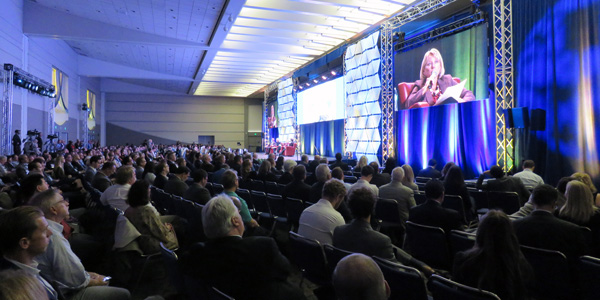By Jason Fordney
SACRAMENTO, Calif. — The rapidly changing energy landscape in the Western U.S. was the recurring theme at CAISO’s 2017 Stakeholder Symposium last week. About 1,000 attendees from the industry, its disruptors and other counterparts gathered at the Sacramento Convention Center.
This year, the ISO expanded the scope of the conference by inviting representatives from agriculture, Western oil and gas companies, and the commercial development industry to present fresh perspectives. The discussions revealed that policymakers, those responsible for grid reliability and large energy-using industries have accepted California’s legislative, regulatory and public commitment to renewables.
But there are many questions about what lies on the road ahead. California’s evolving mix of technologies and complex policymaking structure has placed much attention on a state that would boast the sixth largest economy in the world if it were an independent country.
A wide range of stakeholders, particularly those from neighboring states, are grappling with the questions of creating an RTO and a changing model for electricity delivery and consumption that is moving toward storage and distributed energy resources. Rising consumer costs and other impacts on the public were themes interwoven into the talks, and memories of the 2000-2001 Western Energy Crisis linger like ghosts among California policymakers.
Renewable Interests Discuss Storage
Participants on an Oct. 18 panel discussion of energy storage focused on the reliability and cost considerations of renewables and how energy storage can be used to better balance variable wind and solar output.
Storage is seen as the next wave in California energy development because of the large amount of photovoltaic and thermal solar coming online, panelists said. Concerns center on replacing the ramping ability of traditional generation, a role that would be suitable for responsive energy storage devices.
High-volume, bulk storage allows solar thermal plants to act like a traditional generating station, SolarReserve CEO Kevin Smith said. The California market is headed toward 50% renewables and beyond, but there are problems related to the “duck curve” and negative energy prices due to overgeneration. To reach the goal of reaching even 50% zero-carbon sources, “you are going to have to have thousands of megawatts of energy storage,” Smith said.
“Largely, renewable generation is going to have to go towards energy storage,” he said. Solar PV plus batteries can provide short-term ramping capability of up to an hour, but longer ramping capability will be needed to meet system needs.
First Solar CEO Mark Widmar said “Solar 1.0” was about attaining as much solar energy as possible, while “Solar 2.0” will be “incorporating flexibility and controllability.”
“Solar 3.0” will be about integration of storage. Other countries and states are looking to California to see how it is handling such a large influx of renewables, he said.
“Everyone is looking at California, particularly in the States,” Widmar said. “Everyone wants to know how California is going to create a sustainable market.”
The conversation around renewables often revolves around subsidies, but “maybe the market just needs to get the values right without overriding policies that skew that,” Ormat Technologies Executive Director Paul Thomsen said.
California utilities have procured a great volume of low-cost renewable compliance solar, “and now they are struggling with the best fit, and that is where we are today,” said Thomsen, a former member of the Nevada Public Utilities Commission. The market will provide the needed products, he said. “But we are not going to do it unless you give us a price signal.”
Other Sectors Weigh in
To bring new voices into the conversation, CAISO invited representatives from the New Buildings Institute (NBI), California Farm Bureau Federation (CFBF) and Western States Petroleum Association (WSPA) to discuss how they are managing the changing electric grid.
WSPA President Catherine Reheis-Boyd said that big changes are also happening rapidly in the petroleum industry: “It is not just the electricity industry; it is ours as well.”
Despite California’s moves to electrify the transportation sector, there are still 26 million internal combustion engines in the state, compared with about 200,000 to 250,000 electric vehicles. California is the third largest consumer of transportation fuels in the world, she said, and the industry produces 3 million gallons of gasoline and diesel every hour.
“We are going to be with you in this conversation for a while, at least for the foreseeable future,” Reheis-Boyd said, and “very much a part of this mix.” The magnitude and timing of electrification is extremely important, she added.
NBI CEO Ralph DiNola said the group is committed to energy efficiency research in design and construction. “It is clear that California policy is driving toward electrification, and I think the building sector is front and center.” Buildings serve as the nexus to the grid, he said, and can be designed and built as grid assets that can be managed and implemented.
A large percentage of energy is used by agricultural producers to pump water to irrigate crops and other after-harvest applications, CFBF attorney Karen Norene Mills said. Many have made investments to adjust to the existing time-of-use rate structure and the incentives matched their practices.
“Our members are struggling with what is happening with the changing landscape,” she said, particularly changing rate structures. “We are finding as we talk to them that there are some real challenges with that.” In the past they have been able to manage their systems and set up operations so they could pump off-peak, and if that is changing, their investments will not be as effective as they have been.





